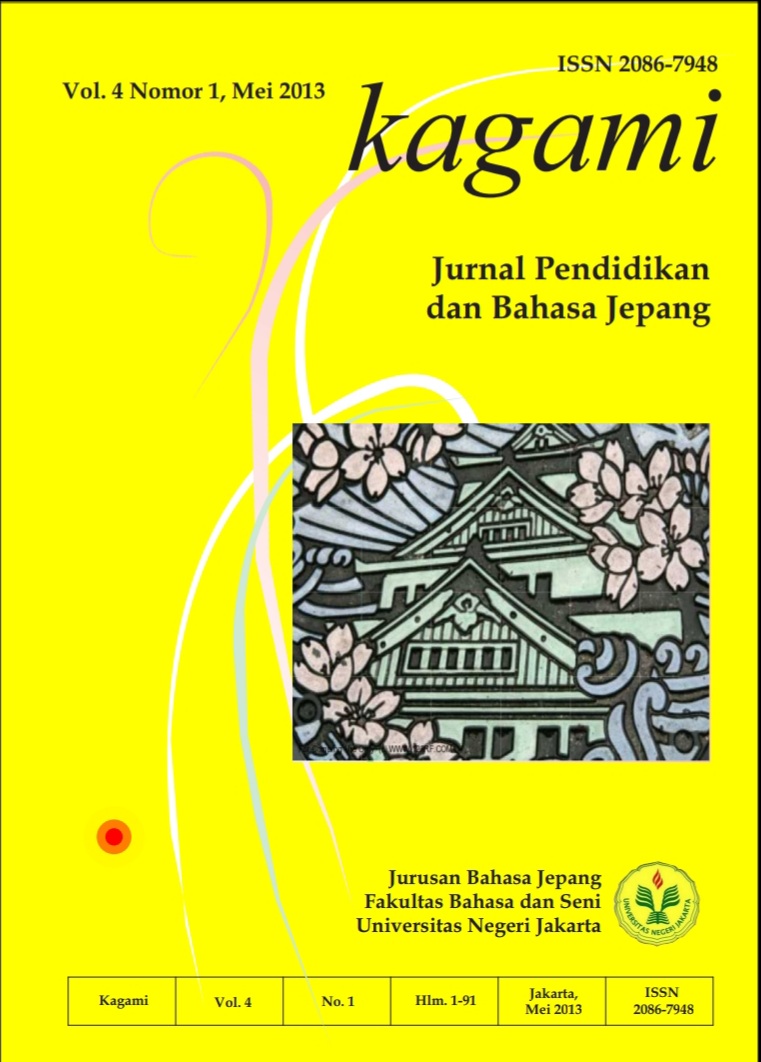Analisis Kesalahan Partikel Mahasiswa Program Studi Sastra Jepang Universitas Nasional PASIM
Abstract
This research designate about wrong way in used particle (joshi) looked from meaning side,
function and how to use in japanesse sentence. In this research data resulted from tes result
and interview for knowing as far as comprehension responden in this thing National
University of PASIM’s student, about particle (joshi). The result has obtained from this
research is the discovery of some wrong way to used the particle and the factors that cause
the error, but it was found also an effort to reduce these error. The Mistakes made by the
respondents in the use of the particles is due to a lack of understanding of the respondent to
the meaning, function and how to use it, such as the use of particles “de” acknowledge
reason, but some of respondents answered incorrectly because they don’t know the meaning
and function of that particle, or in using particle ‘ni’ that using in causative (shieki) sentences,
in this question majority respondents choose ‘o’ as answers because look at the verb that
using in the sentence is transitive verb ‘yaru’. The respondents not understand that in
causative (shieki) sentence the exact particle for that sentence is ‘ni’
References
(2) Association of International Education Japan & Japan Foundation (2001) Nihongo
Nouryoku Shiken 2000. Tokyo: Bonjinsha.
(3) Iori, Isao dkk. (2001) Shokyuu o Oshieru Hito No Tame no Nihongo: Bunpou
Handobaggu. Tokyo: Surii ee Netto Wakku.
(4) Kimura, Muneo (1988). Dasar-Dasar Metodologi Pengajaran Bahasa Jepang. Bandung:
Percetakan Ekonomi.
(5) Kitahara, Yasuo (2003) Meikyou Kokugo Jiten Keitaiban. Tokyo: Daishuukanshoten.
(6) Naoko Chino (2002) Partikel Penting Bahasa Jepang. Jakarta: Kesaint Blanc.
(7) Naoko, Chino & Miharu, Akimoto (2002) Gaikokujin no Tame no Joshi. Tokyo: Musashi
no Shoin.
(8) Noda, Hisashi dkk. (2005) Nihongogaku Shuutokusha no Bunpou Shuutoku. Tokyo:
Daishuukanshiten.
(9) Sudjana, Nana & Ibrahim (2009) Penelitian dan Penilaian Pendidikan. Bandung:
Algesindo
(10) Sudjianto & Dahidi, Ahmad (2004) Pengantar Linguistik Bahasa Jepang. Jakarta:
Kesaint Blanc.
(11)Sugihartono (2001) Nihongo no Joshi (Partikel Bahasa Jepang). Bandung: Humaniora.
(12)Sutedi, Dedi (2009) Penelitian Pendidikan Bahasa Jepang. Bandung: Humaniora.
(13)Sutedi, Dedi (2008) Dasar-Dasar Linguistik Bahasa Jepang. Bandung: Humaniora.
(14) Sutedi, Dedi (2002) Nihongo no Bunpou: Tata Bahasa Jepang Tingkat Dasar. Bandung:
Humaniora
(15) Surii Ee Netto wakaku (1998) Minna no Nihongo I Terjemahan dan Keterangan Tata
bahasa. Tokyo: surii Ee Netto Waaku
(16) Surii ee Netto Wakku (1998) Minna no Nihongo II Terjemahan dan Keterangan Tata
Bahasa. Tokyo: surii Ee Netto Waaku
(17)Takamizawa, Hajime dkk. (2004) Shin Hajimete no Nihongo Kyouiku. Tokyo: Bonjinsha.
(18) Tarigan, Henry G & Tarigan Djago (1990) Pengajaran Analisis Kesalahan Berbahasa.
Bandung: Angkasa.




